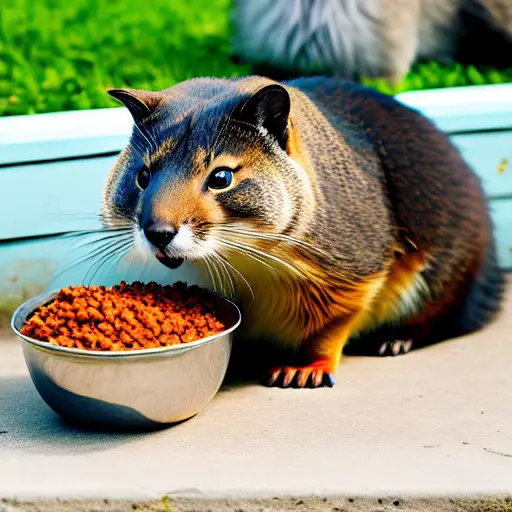As a garden owner, I have always been curious about the eating habits of the wildlife that visit my backyard. One question that has been on my mind lately is whether groundhogs eat cat food.
Groundhogs, also known as woodchucks, primarily consume plant-based materials such as grasses, leaves, and fruits. While it is not common for groundhogs to eat cat food, they may be attracted to it if other food sources are scarce. However, it is not recommended to feed groundhogs cat food, as it does not provide the necessary nutrients for their diet and may cause health issues.
After doing some research and observing these animals in my yard, I have come to the conclusion that groundhogs do indeed eat cat food. However, there are some nuances to this answer that I would like to explore further.
Do Groundhogs Like Cat food?
Before we dive into the specifics of groundhog eating habits, let’s take a closer look at the food in question: cat food. Most cat food is made from meat, which is why it is attractive to groundhogs.
Groundhogs are herbivores, but they will eat small amounts of insects and meat when they can find it.
So while cat food is not a natural part of their diet, it is still something that they will eat if given the opportunity.
When and How Groundhogs Eat Cat Food
Groundhogs are primarily active during the day, so if you leave cat food out overnight, it is unlikely that a groundhog will find it.

However, if you have outdoor cats that eat during the day, groundhogs may try to steal their food.
Groundhogs are known for their digging abilities, so if they can’t reach the food directly, they may dig under fences or other barriers to get to it.
Why Groundhogs Eat Cat Food
Groundhogs are opportunistic eaters, which means that they will eat whatever food is available to them. While cat food is not a natural part of their diet, it is still a good source of protein and other nutrients that they need to survive.
In addition, groundhogs have a high metabolism and need to eat frequently to maintain their energy levels.
Implications for Backyard Owners
If you have outdoor cats and are concerned about groundhogs eating their food, there are a few things you can do.
First, try to feed your cats indoors or in an enclosed area that groundhogs can’t access.
If that’s not possible, try to feed your cats at specific times during the day and remove any uneaten food after a certain period of time.
You can also try using deterrents like motion-activated sprinklers or natural repellents like peppermint oil.
Other Animals That Might Eat Cat Food
While groundhogs are the most likely culprits when it comes to stealing cat food, there are other animals that may also be attracted to it.
Raccoons, opossums, and even skunks have been known to eat cat food when given the opportunity.
If you are concerned about these animals getting into your cat’s food, it’s important to take the same precautions as you would with groundhogs: feed your cats indoors or in an enclosed area, remove uneaten food, and use deterrents if necessary.
How To Keep Groundhogs Out Of Your Yard!
There are several things that can be done to prevent groundhogs from digging and eating stuff in your backyard. I will list some of the strategies below.
Also, see my recent post if you want a full list of my favorite methods to keep groundhogs and gophers away!
1. Using ultrasonic sound
Groundhogs, like other bigger mammals that may invade your garden, tend to have very good hearing. This means that loud or consistent noises will scare them away or at least shorten their visits.
Check out my full buying guide for these ingenious ultrasonic repeller devices here!
One of my favorite technologies to keep pests away from my backyard is these cool solar-powered ultrasonic sound emitters that you can buy right from Amazon! In my experience, they really work, and the solar panels on top save you the time and money of changing batteries all the time.
They will also work against other rodents like gophers, mice, and rats!
2. Sprinkling natural repellents
Groundhogs may be scared off by using natural scents such as coyote urine or predator scents.
They may also cause them to leave if there is a combination of sounds being played from a radio. The sounds include the sound of barking dogs and coyotes.
You can sprinkle dog hair, cayenne pepper or strong enteric oils and other natural repellents around the garden to keep the groundhogs away.
See my complete list of humane ways to keep groundhogs away from your yard for more tips and tricks!
3. Fencing around the garden
You can also fence around your garden to keep groundhogs from entering the garden. It should be at least 3 feet deep and have a double row of fencing.
Groundhogs are good diggers so it has to go underground or they may find a way into the garden even with the fences in place!
4. Using live traps
You can use a live trap to capture groundhogs and move them to another area. Live trapping is currently the most humane way of groundhog control.
Once you have removed all groundhogs from an area, it is important to ensure that they do not come back by using fencing or other barriers to block access.
You can also just buy a live trap, as the sturdy metal ones shown here:
To lure the groundhogs in, you can use one of the numerous favorite foods of groundhogs or an optimized extra attractive formula like this one to make the catch even quicker!
5. Using natural pesticides
There are pesticides or rodent toxins that can be used to kill groundhogs on your property. These may also affect other animals in the area so it is important to ensure that they are only sprayed on the targeted plants.
I do not recommend these, as I prefer more humane ways as described here. Also, anything that kills an animal will also harm humans to some degree, so go for a repellant rather than a toxin if you go the chemical route!
6. Using Scarecrows
You can use a scarecrow in your garden to keep groundhogs away. Groundhogs are afraid of novelty so time-sensitive or motion-activated scarecrows may also be effective in keeping them out of the garden.
7. Using Lights
Groundhogs are not strictly nocturnal animals but they are most active at low light so they do avoid areas with bright lights.
Motion-activated lights, sounds, and sprinklers may help prevent groundhogs from entering your yard.
Any blinking light will confuse and scare away groundhogs from your yard, especially if they are motion activated and sudden!
8. Motion-activated sprinklers
Like most animals, groundhogs hate surprises, and they will run away if suddenly sprayed with water. I like this solution because it is humane, simple, effective, and does not require much time to set up.
The Havahart 5277 is a motion-activated sprinkler that is activated by the movement of animals up to 25 feet away and sprays them with a harmless water jet, frightening them off and keeping them at bay.
The included metal stake makes it easy to install in your garden, and the sprinkler can be rotated 180 degrees for maximum coverage.
In conclusion, groundhogs do eat cat food, but it’s not a natural part of their diet. They are opportunistic eaters and will eat whatever food is available to them.
If you have outdoor cats and are concerned about groundhogs (or other animals) stealing their food, there are steps you can take to prevent it.
By being proactive and taking the necessary precautions, you can ensure that your cats are well-fed and safe from unwanted visitors.















